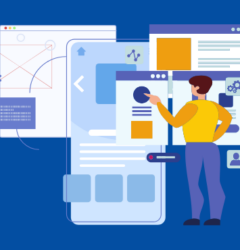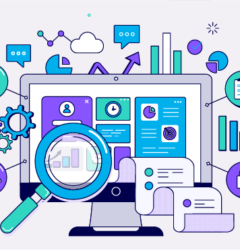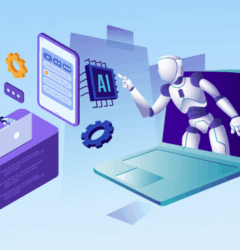
This article was first published on Customer Think.
As the pandemic-induced digital transformation spreads across industries, businesses are continuing to march toward greater integration, automation, and innovation. Companies that will be leaders in their fields will embrace new tools and reimagine how they use technology to remain competitive.
For example, citizen development and digital workspace will remain in the spotlight in a world where:
- The hybrid/remote work environment demands non-technical employees to reduce their reliance on IT.
- Employee experience is as significant as the customer experience.
Here are the 4 key technology predictions in the business and technology worlds for 2024.
1. Citizen development will continue to thrive
The rise of citizen developers (business users who can build custom applications with no-code platforms) is for everyone to see. In the coming year, businesses will increase their investments in formal citizen development programs. It’s no surprise that no-code automation has risen to the top of the CIO priority list. No-code platforms put process innovation tools in the hands of business users, who are closest to the problems. As a result, productivity has increased, and digital transformation has sped up.
The use of these tools will expand and become more structured by 2024. As more businesses understand the value of no-code development, they will establish structured citizen development initiatives that equip their employees with the tools they need to innovate and deliver value. In order to support enterprise innovation, citizen development must be covered at the strategic, tactical, and operational levels. It is critical to form fusion teams and clearly define the roles and responsibilities of not just citizen developers but technical people too.
To ensure that the strategic goals are met, the team should include a citizen development champion who can influence or direct both citizen developers and IT teams. This position is best suited to someone from the top management (CEO or CIO). If the situation calls for it, he or she can also serve as a pacifier between business users and IT personnel.
Simultaneously, IT leaders will put in place no-code development security measures such as platform-level security and access controls. No-code apps will thus integrate enterprise-level throughput with enterprise-level security and compliance.
2. Digital workspaces & workforces will further imprint their footprints
While employees have a say in where, when, and how they work, company leaders are equally focused on creating a post-pandemic workplace. These are some of the top workforce predictions for how companies can craft the ideal employee experience (EX) for increasingly digitalized, sustainable business models, ranging from work-anywhere flexibility to technology-driven individual and team augmentation.
As digitalization alters business models, it also alters how work is accomplished.
Digital intelligence will become integral to workspaces across the globe, which will lead to far-reaching outcomes. By 2023, it is expected that 70% of connected workers in task-based roles will leverage digital intelligence to engage clients/colleagues and drive enterprise productivity. Companies with cross-functional leadership – a digital dream team – will appreciate greater speeds of innovation, higher market share gains, and bigger process efficiency than their competitors by 2025.
Data-driven businesses must provide employees with relevant information, recognizing those who use data in their decision-making. The lack of a meritocracy-based data culture will corrode trust in management, reduce staff morale, and increase turnover in two-thirds of mid to large enterprises by 2024, thereby worsening skills gaps.
Organizations are likely to unfetter the creative thinking of their staff members and engulf them with astute automation and prediction engines that focus on results, not just financial results. It signals a new era of transformation marked by human-centered technology initiatives that connect customer experience (CX) and employee experience (EX) to drive competitive advantage and deliver a 3% to 5% net productivity gain.
Top researchers are also forecasting a “no jobs” framework in which employees will become more cross-functional, investing their skills in project-based work and swarm teams rather than sitting still in a fixed role. The world of “no jobs” will promote a dynamic mix of full-time staff members and internal and external talent marketplaces.
3. Hyperautomation will gain momentum
Humans have an innate desire to ignore or downplay automation because they fear it will substitute their jobs. However, this has not been the case; instead, automation enables employees to better understand and develop new skills that are more suited to their organizations and their own career paths. In reality, automation technology is still not widely available to the general public. It is primarily adopted and implemented at the executive level of businesses. Only when these technologies reach SMBs, will we see the rise of hyperautomation—the belief that anything that can be automated should be automated. In the end, the goal is not to replace jobs, but to create new ones.
While many organizations are still experimenting with process automation, forward-thinking businesses are becoming acquainted with this new reality of “hyperautomation.” Hyperautomation one of the key technology predictions, is the result of an organization’s outlook on automated processes, which incorporates a wide range of technologies like machine learning, artificial intelligence, robotic process automation, no-code capabilities, and others.
As a result, there is an active campaign throughout the enterprise to identify, automate, and optimize business processes. The leadership will have the fortitude to automate legacy applications and build a flexible workforce capable of adapting to changing technologies, operations, and business requirements.
Many organizations are dabbling with cutting-edge technologies and tools that non-technical employees from different domains can utilize in order to build a stack of automation solutions and accomplish enterprise-wide automation at a breakneck pace in an agile, responsive, and time-efficient manner.
Given that cross-enterprise processes are the foundation of digital enterprises, automated systems that can continuously enhance the way people, processes, and technology interact will have tremendous influence. More enterprises will integrate AI into their processes over the next few years, enriching their decision-making, suggestions, and enhancement with actionable insights.
Also Read: Hyperautomation – What, Why, and How?
4. iPaaS will gain prominence
In 2023, companies that are able to rectify end-to-end business challenges for their customers with a well-integrated suite of products will be the winners of the future. This includes not only providing iPaaS capabilities but also exposing APIs so that they can build mobile, web, and conversational apps that allow them to automate tasks using their existing apps. Building integrations with no-code solutions will eventually be replaced by a conversation with a chatbot, essentially detailing the business need in order to build the appropriate application.
For the unversed, Integration Platform as a Service (iPaaS) is a suite of cloud services that enables the development, execution, and governance of integration flow responsible for connecting on-premises and cloud-based applications – across multiple organizations.
Finally, the courage to embrace emerging solutions rather than sticking to the ways of the past—or even the ways of today—will be the defining characteristic of the competitive business of the future. These companies will seize technology predictions for 2024 by introducing new integration capabilities, workspaces, experts, and automation into their domain.
Login
Please login to comment
0 Comments
Oldest
















